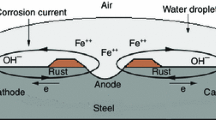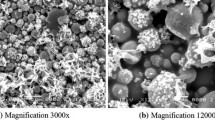Abstract
The use of oxides, such as chromates, is highly effective in corrosion protection. Scientists are looking at alternative materials to replace environmentally hazardous materials, e.g., chromates. One of the group of materials identified as corrosion inhibiting are intrinsically conducting polymers.
This paper focuses on the use of ICPs as a possible corrosion inhibitive substance. This paper also reviews literature on the research of different groups on the use of polyaniline and other conducting polymers as corrosion inhibitors. Intrinsically conducting polymers, especially poly-aniline, are being studied with great interest. Studies indicate that they have the potential of replacing some of the currently available materials.
Similar content being viewed by others
References
Heeger, A.J., Smith, P., Fizzi, A., Moulton, J., Pakbaz, K., and Rughooputh, S., “Recent Progress in Conducting Polymers—Opportunities for Science and Opportunities for Technology,”Synthetic Metals, 41–43, 1027–1032 (1991).
Alcacer, L.,The Physics and Chemistry of Low Dimensional Solids, D. Reidel Publ. Co., Boston, MA, 1980.
Seymour, R.B. (Ed.),Conductive Polymers, Plenum Press, NY, 1981.
Schoch, K.F., “Electrically Conductive Polymers and Their Applications,”IEEE Electrical Insulation Magazine, 2, No. 1, 20–26, (1986).
Kinlen, P.J. and Silverman, D.C., Monsanto Interin Report, No. MSL 13430 (1994).
Zipperling Kessler & Co., Polyaniline Technical Literature (1995).
Diaz, A.F. and Logan, J.A., Journal of Electroanalytical Chemistry, Vol. 111, 111 (1980).
Hung, L.C.P., “Chemical Preparation of Electrically Conducting Polyaniline/Poly(vinyledene chloride) Composite Film,” UMR Thesis, 1990.
Epstein, A.J., and MacDiarmind, A.G., “Polyaniline: Solutions, Films, and Oxidation State,”Proc. Faraday Society, Faraday Trans, 1989.
DeBerry, D.W. and Viehbeck, A., “Fundamental Aspects of Corrosion Protection by Surface Modification,” McCafferty, E., Clayton, C.R., and Oudar, J. (Ed.),The Electrochemical Society Softbound Proceedings Series, 308–323, Pennington, NJ, 1984.
DeBerry, D.W., “Modification of the Electrochemical and Corrosion Behavior of Stainless Steel with an Electroactive Coatings,”J. Electrochem. Soc., 132, No. 5, 1022 (1985).
Ahmad, N.H. and MacDiarmid, A.G.,Bulletin of American Physics Society, 32, No. 3, 548 (1987).
Deng, Z., Smyrl, W.H., and White, H.W., “Stabilization of Metal-Metal Oxide Surfaces Using Electroactive Polymer Films,”J. Electrochem. Soc., 136, No. 8, 2152 (1989).
Deng, Z. and Smyrl, W.H., “Application of Electroactive Films in Corrosion Protection,”J. Electrochem. Soc., 138, No. 7, 1911 (1991).
Thompson, K.G., Bryan, C.J., Benicewicz, B.C., and Wrobleski, D.A., “Los Alamos National Laboratory, Report LA-UR-92-360,” “Corrosion Resistant Coatings From Conducting Polymers,”ACS Polymer Preprints, 35, No. 1, 265 (1994).
Beck, F., “A Novel Way to Corrosion Protection: The Electrochemical Deposition of Conducting Polymers,”Metalloberflaeche, Vol. 46, No. 4, 177 (1992).
Troch-Nagels, G., Winand, R., Weymeersch, A., and Renard, L., “Electron Conducting Organic Coating of Mild Steel by Electropolymerization,”J. Applied Electrochem., 22, 756 (1992).
Sekine, I., Kohoara, K., Sugiyama, T., and Yuasa, M.,J. Electrochem. Soc., 1398, 2090 (1992).
Sathiyanarayan, S., Balakrishnan, K., Dhawan, S.K., and Trivedi, D.C.,Corrosion Science, 33, 1831 (1992).
Geskin, V.M., “Electrodeposition of Polyaniline Onto Non-Noble Metals II. Nickel,”J. Chem. Physics, 89, 1221 (1992).
Wessling, B., “Passivation of Metals by Coatings with Polyaniline: Corrosion Potential Shift and Morphological Changes,”Adv. Materials, 6, No. 3, 226 (1994).
Lu, W.K., Elsenbaumer, R.L., and Wessling, B., “Corrosion Protection of Mild Steel by Coatings Containing Polyaniline,” paper at the ICSM, Seoul, 1994.
Jasty, S. and Epstein, A.J., “Corrosion Prevention Capability of Polyaniline (Emeraldine Base and Salt: An XPS Study),”ACS Polymer Preprints, 36, 565 (1995).
Wei, Y., Wang, J., Jia, X., Yeh, J., and Spellane, P.,ACS Polymer Preprints, 36, 563–564 (1995).
Sitaram, S.P., Yu, P., O’Keefe, T.J., and Stoffer, J.O.,ACS Polymer Preprints, 1996.
Author information
Authors and Affiliations
Additional information
Materials Research Center, Straumanis Hall, Rolla, MO 65401-0249.
Rights and permissions
About this article
Cite this article
Sitaram, S.P., Stoffer, J.O. & O’Keefe, T.J. Application of conducting polymers in corrosion protection. Journal of Coatings Technology 69, 65–69 (1997). https://doi.org/10.1007/BF02696146
Issue Date:
DOI: https://doi.org/10.1007/BF02696146




